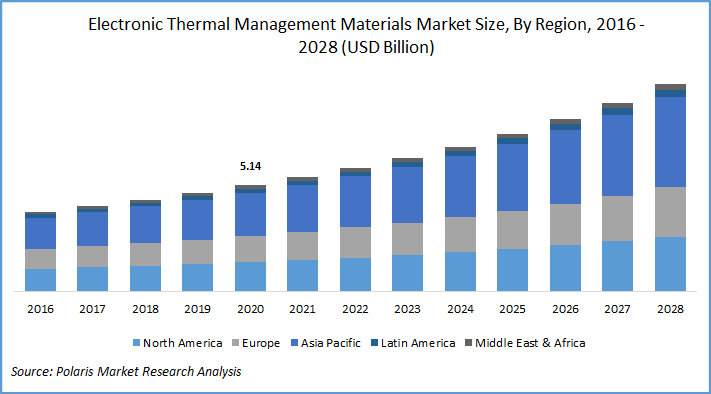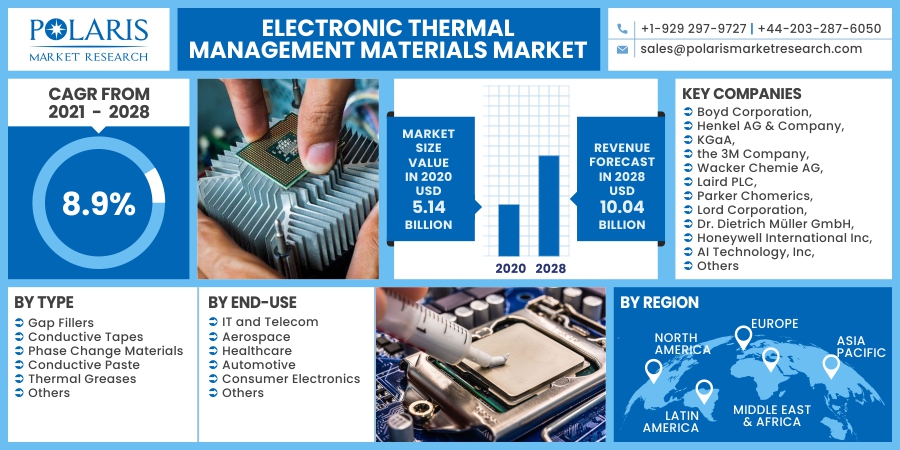
Electronic Thermal Management Materials Market Share, Size, Trends, Industry Analysis Report, By Type (Gap Fillers, Conductive Tapes, Phase Change Materials, Conductive Paste, Thermal Greases); By End-Use (IT & Telecom, Aerospace, Healthcare, Automotive, Consumer Electronics); By Regions; Segment Forecast, 2021 - 2028
- Published Date:Mar-2021
- Pages: 118
- Format: PDF
- Report ID: PM1828
- Base Year: 2020
- Historical Data: 2016 - 2019
Report Outlook
The global electronic thermal management materials market size was valued at USD 5.14 billion in 2020 and is expected to grow at a CAGR of 8.9% during the forecast period. The thermal management materials are increasingly being used in circuits and components across industries such as healthcare, consumer electronics, automotive, aerospace, and telecommunication among others.
The demand for the thermal management materials has increased owing to the miniaturization of circuits and the greater demand for compact devices with higher density, complexity, and output. The use of these materials improves the performance of circuits by offering improved thermal conductivity, insulation, and dissipation.

Know more about this report: request for sample pages
These materials are being used in the automotive and transportation sector for affordable and high-performing thermal management for modernized vehicles. Power devices in computer servers, industrial, and energy applications are also integrated with these products for improved efficiency. Rising industrialization, growing urbanization, and increasing demand from the automotive and transportation sector drive the market growth of the thermal management materials.
Increasing modernization of vehicles, rise in market demand for passenger vehicles, and growing electrification of vehicles has necessitated the use of the thermal management materials for enhanced connectivity and reliability. The introduction of stringent vehicular safety regulations in the market, the development of autonomous vehicles, and the adoption of smart transportation management solutions have further fueled the growth of the thermal management materials market across the globe.
The thermal management materials such as gap fillers, conductive tapes, and thermal greases are used in consumer electronics for enhanced performance. The increasing market trend of smaller and compact mobile devices has increased the demand for the thermal management materials. These products provide high mechanical and conductive properties.
Industry Dynamics
Growth Drivers
Increasing penetration of smartphones across the global market coupled with the growing demand for mobile applications, such as business and communication apps, gaming apps, health & wellness apps, increasing disposable income, and changing lifestyle of consumers, especially in urban areas has increased the demand for consumer electronics, thereby fueling the market growth of the thermal management materials market.
Electronic thermal management materials are being used in medical devices such as diagnostics tools, monitoring devices, and implantable devices. These products enhance the performance, reliability, and efficiency of equipment such as patient monitoring systems, imaging systems, biochemical analysis equipment, and other IT equipment.
Increasing expenditure in the healthcare sector, greater need to offer affordable healthcare services to patients, and growing adoption of wearable medical products has increased the adoption of the thermal management materials. The aerospace & defense sectors have experienced increased demand for electronic thermal management materials owing to greater development of power-efficient and higher power density components. Increasing safety concerns and growing expenditure on technologically advanced weapon systems in the market have resulted in the development of directed-energy weapons, perimeter security solutions, barrier systems, and UAVs.
These systems require the integration of electronic circuits responsible for electric power generating, auxiliary power units, power distribution, management and control systems, environmental control systems, location-based services. Stringent safety regulations and the need for highly efficient systems in these sectors have significantly increased the market demand for electronic thermal management materials.

Know more about this report: request for sample pages
Electronic Thermal Management Materials Market Report Scope
The market is primarily segmented on the basis of type, end-use, and region.
|
By Type |
By End-Use |
By Region |
|
|
|
Know more about this report: request for sample pages
Type Outlook
The type market segment has been divided into gap fillers, conductive tapes, phase change materials, conductive paste, greases, and others. The conductive paste segment accounted for a major share in 2019 owing to increased use in diverse industries such as aerospace, healthcare, and automotive among others.
Rapid technological advancements coupled with the miniaturization of electronic components and the need for lightweight electronic assemblies are factors fueling the market growth of this segment. Conductive paste offers superior adhesive strength, and high heat and electric conductivity, increasing its market demand across varied industries.
End-Use Outlook
On the basis of end-user, the market is segmented into IT and telecom, aerospace, healthcare, automotive, consumer electronics, and others. The consumer electronics segment dominated the global market in 2020. The sector makes use of electronic thermal management materials for heat management and reduced heat resistance.
The use of thermal management materials in consumer electronics improves performance while prolonging the product lifetime of electronic assemblies. Factors such as increasing disposable income, improving living standards, technological innovation, and growing penetration of mobile devices boost the growth of this segment.
Regional Outlook
Asia Pacific dominated the global electronic thermal management materials market in 2020. Increasing urbanization, growing consumer spending, expansion of international players in this region, and technological advancements are some of the additional factors attributed to the growth in this region. The industrial growth in countries such as China, India, and Japan, the presence of major electronics manufacturers, and supportive government initiatives supporting manufacturing influence the market in this region.
Rising applications in aerospace and healthcare applications have increased the demand for electronic thermal management materials in the region. Increasing modernization of vehicles and initiatives to promote the use of electric vehicles in developing countries of the region is expected to drive the electronic thermal management materials market growth.
Competitive Landscape
The leading players in the electronic thermal management materials market include Boyd Corporation, Henkel AG & Company, KGaA, the 3M Company, Wacker Chemie AG, Laird PLC, Parker Chomerics, Lord Corporation, Dr. Dietrich Müller GmbH, Honeywell International Inc, AI Technology, Inc, DuPont, European Thermodynamics Ltd., Darcoid company, and Marian Inc.
